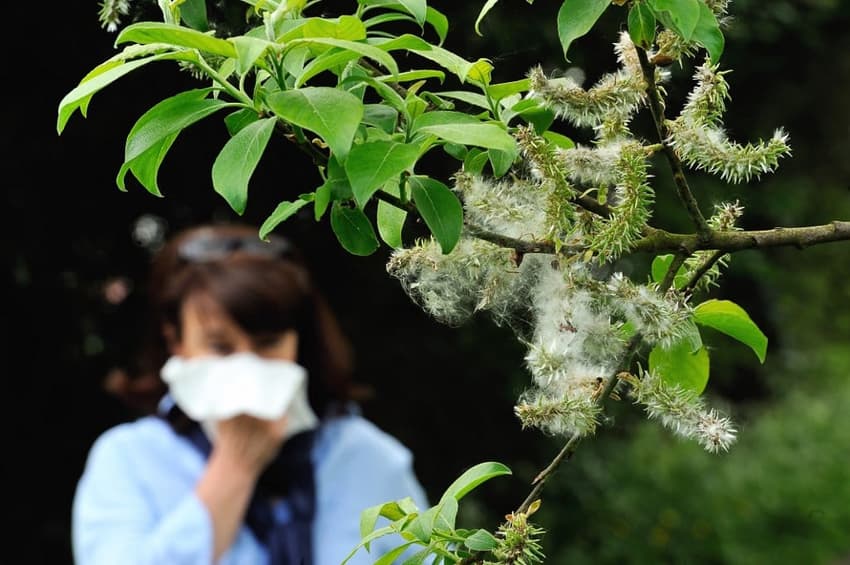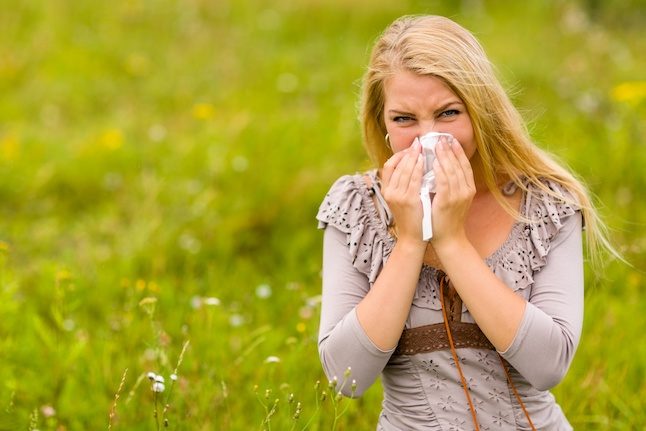Pollen allergies in Spain: What you need to know

More than a third of the population in Spain has some allergy to pollen and health issues caused by these outdoor allergens are only set to increase in the coming years. Here's everything you need to know about hay fever in Spain.
Allergies affect eight million people in Spain, according to the Spanish Society of Allergology and Clinical Immunology (Seaic) and people are mainly affected during the spring and summer seasons.
High temperatures caused by climate change are increasing the amount of pollen in the air, which in turn is causing the number of pollen-related allergies such as hay fever to rise too.
According to Dr. Ángel Moral, president of the Seaic Aerobiology Committee, more than a third of the population in Spain has some pollen allergy problem. This could be in the form of an itchy nose, watery eyes, sneezing or even breathing difficulties, which makes it one of the most frequent illnesses in the country.
Why do allergies increase in spring and summer and where in Spain are they the worst?
Allergenic pollens vary according to the time of year and the type of vegetation. In general, tree pollen dominates during the winter and early spring, while grasses produce higher levels during spring and summer, according to the University Clinic of Navarra.
Each species has a different pollination period, which can also vary depending on the region. The level of grass pollen, for example, lasts until August in the north of the peninsula. On the other hand, on the Mediterranean coast, it lasts until the end of October.
Olive pollen, the other main species in May, is almost non-existent in the northern provinces, but high in the south and the Mediterranean.
According to the experts, the regions most badly affected by pollen in Spain are Andalusia, Castilla La-Mancha, Catalonia, Extremadura, Madrid and Murcia. If you want a live update of pollen levels in your part of Spain, click here.
What types of plants and pollen are people allergic to in Spain?
The two most important pollens these days are olive and grass, according to Dr. Moral. "There are more people allergic to grasses in Spain than in practically the whole world," he explained.
Of the eight million people with allergies in Spain, seven million are allergic to grasses, olive trees, arizonica, shade banana, salsola and parietaria.
Many people are also allergic to the seeds from plane trees, which can often cause sneezing and coughing fits. Experts suggest that plane trees, along with other species of trees, are one of the main sources of volatile compounds.
Barcelona Zoo states that today, plane trees are the most commonly planted tree in the cities and gardens throughout the Spanish Mediterranean region. They are typically planted in cities because of their ability to trap pollution particles on their leaves and bark.

Avoid spending a lot of time outside on days when the pollen count is particularly high in your area of Spain. Photo: Public Domain Photos.net/Pixabay
Pollen season is set to get longer and the number of people suffering from allergies to increase
New research suggests that the pollen season is getting longer and longer each year due to climate change.
The increase in carbon dioxide is also fuelling photosynthesis, so plants may grow larger and produce even more pollen. Extensive research over the past decade has shown that airborne pollen has increased not just in Spain, but all over the world.
Seaic believes that because of this, the number of hayfever sufferers is set to increase too.
For example, in Madrid, the level of pollen in the air has doubled in the last 25 years. In 1995, an average of 25,000 grains per cubic meter was collected while the average for the year 2020 was more than 60,000, according to data collected by the Palinocam Network.
What to do in Spain if you suffer from hay fever?
According to the Department of Allergology of the University Clinic of Navarra symptoms can be treated with oral or topical antihistamines. They are effective in reducing itching, sneezing and runny nose. Nasal decongestants are also effective and often serve to prevent the onset of symptoms.
However, they also suggest limiting your exposure to pollen, which can prove difficult. Suggestions from health clinics on limiting exposure include:
- Avoiding spending a lot of time outside on days when the pollen count is particularly high.
- Avoiding the times between 5am and 10am and 7pm to 10pm when pollen levels are at their highest.
- Keeping your windows up when driving.
- Not drying your clothes outside when the pollen counts are high as grains can stick your clothing.
- Showering when coming in from outside.
If you want to see a allergist (alergólogo/a in Spanish), this map by the Spanish Society of Allergology should direct you to your closest specialist.
Comments
See Also
Allergies affect eight million people in Spain, according to the Spanish Society of Allergology and Clinical Immunology (Seaic) and people are mainly affected during the spring and summer seasons.
High temperatures caused by climate change are increasing the amount of pollen in the air, which in turn is causing the number of pollen-related allergies such as hay fever to rise too.
According to Dr. Ángel Moral, president of the Seaic Aerobiology Committee, more than a third of the population in Spain has some pollen allergy problem. This could be in the form of an itchy nose, watery eyes, sneezing or even breathing difficulties, which makes it one of the most frequent illnesses in the country.
Why do allergies increase in spring and summer and where in Spain are they the worst?
Allergenic pollens vary according to the time of year and the type of vegetation. In general, tree pollen dominates during the winter and early spring, while grasses produce higher levels during spring and summer, according to the University Clinic of Navarra.
Each species has a different pollination period, which can also vary depending on the region. The level of grass pollen, for example, lasts until August in the north of the peninsula. On the other hand, on the Mediterranean coast, it lasts until the end of October.
Olive pollen, the other main species in May, is almost non-existent in the northern provinces, but high in the south and the Mediterranean.
According to the experts, the regions most badly affected by pollen in Spain are Andalusia, Castilla La-Mancha, Catalonia, Extremadura, Madrid and Murcia. If you want a live update of pollen levels in your part of Spain, click here.
What types of plants and pollen are people allergic to in Spain?
The two most important pollens these days are olive and grass, according to Dr. Moral. "There are more people allergic to grasses in Spain than in practically the whole world," he explained.
Of the eight million people with allergies in Spain, seven million are allergic to grasses, olive trees, arizonica, shade banana, salsola and parietaria.
Many people are also allergic to the seeds from plane trees, which can often cause sneezing and coughing fits. Experts suggest that plane trees, along with other species of trees, are one of the main sources of volatile compounds.
Barcelona Zoo states that today, plane trees are the most commonly planted tree in the cities and gardens throughout the Spanish Mediterranean region. They are typically planted in cities because of their ability to trap pollution particles on their leaves and bark.

Pollen season is set to get longer and the number of people suffering from allergies to increase
New research suggests that the pollen season is getting longer and longer each year due to climate change.
The increase in carbon dioxide is also fuelling photosynthesis, so plants may grow larger and produce even more pollen. Extensive research over the past decade has shown that airborne pollen has increased not just in Spain, but all over the world.
Seaic believes that because of this, the number of hayfever sufferers is set to increase too.
For example, in Madrid, the level of pollen in the air has doubled in the last 25 years. In 1995, an average of 25,000 grains per cubic meter was collected while the average for the year 2020 was more than 60,000, according to data collected by the Palinocam Network.
What to do in Spain if you suffer from hay fever?
According to the Department of Allergology of the University Clinic of Navarra symptoms can be treated with oral or topical antihistamines. They are effective in reducing itching, sneezing and runny nose. Nasal decongestants are also effective and often serve to prevent the onset of symptoms.
However, they also suggest limiting your exposure to pollen, which can prove difficult. Suggestions from health clinics on limiting exposure include:
- Avoiding spending a lot of time outside on days when the pollen count is particularly high.
- Avoiding the times between 5am and 10am and 7pm to 10pm when pollen levels are at their highest.
- Keeping your windows up when driving.
- Not drying your clothes outside when the pollen counts are high as grains can stick your clothing.
- Showering when coming in from outside.
If you want to see a allergist (alergólogo/a in Spanish), this map by the Spanish Society of Allergology should direct you to your closest specialist.
Join the conversation in our comments section below. Share your own views and experience and if you have a question or suggestion for our journalists then email us at [email protected].
Please keep comments civil, constructive and on topic – and make sure to read our terms of use before getting involved.
Please log in here to leave a comment.